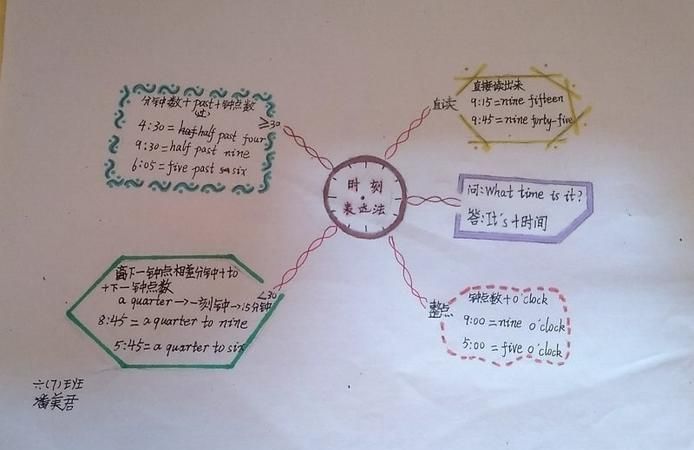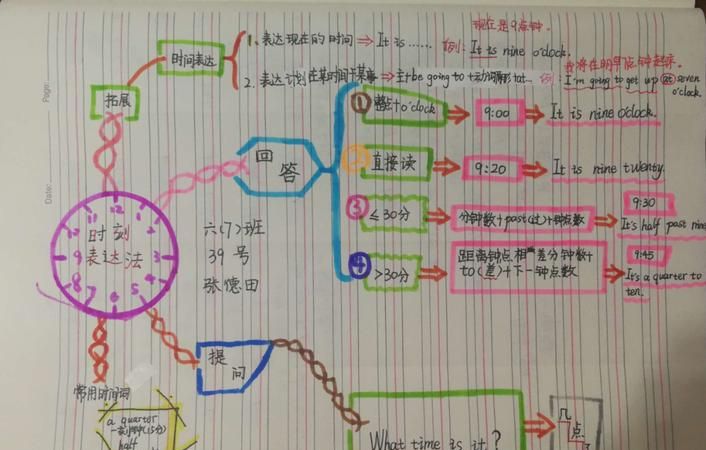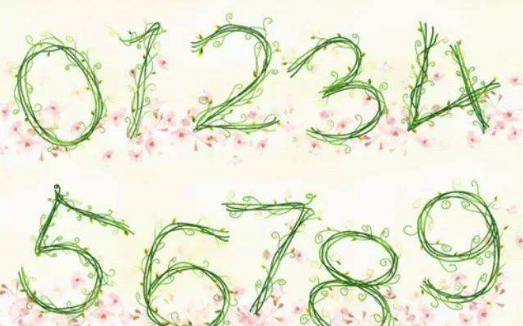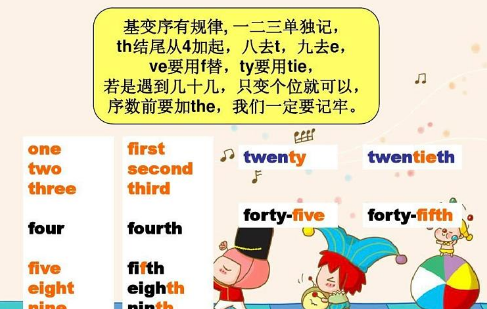有关基数和序数的思维导图英语 想必大家都想知道。今天就给家解读一下。英语的基数和序数和求教:英语中基数词与序数词的区别和用法!基数和序数的思维导图英语 的内容,方便您深入了解教:英语中基数词与序数词的区别和用法,那么一起看看吧。
基数和序数的思维导图英语 :用英语翻译基数和序数
基数cardinal number

基数和序数的思维导图英语 :教:英语中基数词与序数词的区别和用法
一、 数词的分类
1. 基数词
表示数目的词称为基数词。其形式如下:
A.从1——10
one,two,three,four,five,six,seven,eight,nine,ten.
B.从 11——19
eleven,twelve, thirteen, fourteen, fifteen, sixteen, seventeen,eighteen, nineteen.
这里除 eleven, twelve, thirteen, fifteen, eighteen为特殊形式外,fourteen,sixteen,seventeen,nineteen都是由其个位数形式后添加后缀-teen构成。
C.从 21——99
整数几十中除twenty,thirty, forty,fifty,eighty为特殊形式外,sixty,seventy,ninety都是其个位数形式后添加后缀-ty构成。表示几十几时,在几十和个位基数词形式之间添加连字符“-”
21 twenty-one
76 seventy-six
D.百位数
个数基数词形式加“hundred”,表示几百,在几十几与百位间加上and.
101 a hundred and one
320 three hundred and twenty
648 six hundred and forty-eight
E.千位数以上
从数字的右端向左端数起,每三位数加一个逗号“,”。从右开始,第一个“,”前的数字后添加 thousand,第二个“,”前面的数字后添加 million,第三个“,”前的数字后添加 billion。然后一节一节分别表示,两个逗号之间最大的数为百位数形式。
2,648 two thousand six hundred and forty-eight
16,250,064 sixteen million two hundred and fifty thousand sixty-four
5,237,166,234 five billion,two hundred and thirty-seven million,one hundred and sixty-six thousand,two hundred and thirty-four
F.基数词在表示确切的数字时,不能使用百、千、百万、十亿的复数形式;但是,当基数词表示不确切数字,如成百、成千上万,三三两两时,基数词则以复数形式出现。
There are hundreds of people in the hall.
大厅里有数以百计的人。
Thousands and thousands of people come to visit the Museum of Qin Terra-Cotta Warriors and Horses every day.
每天有成千上万的人来参观秦兵马涌博物馆。
They went to the theatre in twos and threes.
他们三三两两地来到了剧院。
G.表示人的不确切岁数或年代,用几十的复数形式表示。
He became a professor in his thirties.
他三十多岁时成为了教授。
She died of lung cancer in forties.
她四十来岁时死于肺癌。
It was in the 1960s.
那是在二十世纪六十年代。
H.基数词的句法功能
基数词在句中可作主语、宾语、定语、表语、同位语。
The two happily opened the box.
两个人高兴地打开了盒子。(作主语)
I need three altogether.
我总共需要三个。(作宾语)
Four students are playing volleyball outside.
四个学生在外面打排球。(作定语)
We are sixteen.
我们是16个人。(作表语)
They three tried to finish the task before sunset.
他们三个人尽力想在日落前完成任务。(作同位语)
2. 序数词
表示顺序的词称为序数词。序数词的主要形式:
A.从第一至第十九
其中,one— first, two— second, three— third, five— fifth,eight—eighth,nine—ninth,twelve— twelfth为特殊形式,其它的序数词都是由其相对应的基数词后面添加“th”构成。例如: six— sixth、nineteen— nineteenth.
B.从第二十至第九十九
整数第几十的形式由其对应的基数词改变结尾字母y为i,再加“eth”构成。
twenty——twentieth thirty——thirtieth
表示第几十几时,用几十的基数词形式加上连字符“-”和个位序数词形式一起表示。
thirty-first 第三十一
fifty-sixth 第五十六
seventy-third 第七十三
ninety-ninth 第九十九
C.第一百以上的多位序数词
由基数词的形式变结尾部分为序数词形式来表示。
one hundred and twenty-first 第一百二十一
one thousand,three hundred and twentieth 第一千三百二十
D.序数词的缩写形式
有时,序数词可以用缩写形式来表示。主要缩写形式有。
first——lst second——2nd third——3rd
fourth——4th sixth——6th twentieth——20th
twenty-third——23rd
其中lst,2nd,3rd为特殊形式,其它的都是阿拉伯数字后加上th。
E.序数词的句法功能
序数词在句中可作主语、宾语、定语和表语。
The second is what I really need.
第二个是我真正需要的。(作主语)
He choose the second.
他挑选了第二个。(作宾语)
We are to carry out the first plan.
我们将执行第一个计划。(作定语)
She is the second in our class.在我们班她是第二名。(作表语)
注:序数词在使用时,通常前面要加定冠词 the;但是如果序数词前出现不定冠词a或an时,则表示“再——”,“又——”。
We/’ll go over it a second time.
我们得再念第二遍。
We/’ve tried it three times.Must we try it a fourth time?
我们已经试过三遍了,还必须试一次(第四次)吗?
另外,基数词也可以表示顺序。只需将基数词放在它所修饰的名词之后即可,不需要添加定冠词。
the first lesson——Lesson One
the fifth page——Page 5(five)
the twenty-first room——Room 21(twenty-one)
二、时刻表示法
1. 表示几点钟用基数词加可以省略的o/’clock
5:00 读作 five o/’clock 或 five
2. 表示几点过几分,在分钟后加past,再加小时
five past seven 七点过五分
half past six 六点半
a quarter past eight 八点过一刻
seven past eight 八点过七分 3. 表示几点差几分,在分钟后面加to,再加小时
ten to eight 差十分八点(七点五十分)
a quarter to twelve 差一刻十二点(十一点四十五分)
twenty to six 差二十分六点(五点四十分)
在日常生活中,常用下列简单方法表示时间。
以小时、分种为单位分别读出数字。
6:31 读作 six thirty-one
10:26 读作 ten twenty-six
14:03 读作 fourteen o three
16:15 读作 sixteen fifteen
18:30 读作 eighteen thirty
23:55 读作 twenty-three fifty-five
注:时刻表上的时间大多采用24小时表示法,这样就不需要用a.m.表示上午,p.m.表示下午了。
三、年月表示法
1. 世纪可以用定冠词加序数词加世纪century表示,也可以用定冠词加百位进数加/’s表示
the sixth(6th)century 公元六世纪
the eighteenth(18th)century 公元十八世纪
the 1900/’s 二十世纪
the 1600/’s 十七世纪
这里,用百位数整数表示的世纪比这一百位阿拉伯数字本身多一个世纪。
2. 年代用定冠词及基数词表示的世纪加十位整数的复数形式构成
in the 1930/’s(in the thirties of the twentieth century或 in the nineteen thirties)
在二十世纪三十年代
in the 1860/’s(in the sixties of the 19th century或 in the eighteen sixties)
在十九世纪六十年代
In the 1870/’s when Marx was already in his fifties,he found it important to study the situation in Russia,so he began to learn Russian.
在十九世纪七十年代当马克思已经五十多岁时,他发现研究俄国的形势很重要,便开始学习俄语。
3. 表示某年代的早期、中期和晚期,可以在定冠词后,年代前添加 early,mid-,late
in the early 1920/’s 在二十世纪二十年代早期
in the mid-1950/’s 在二十世纪五十年代中期
4. 年月日表示法
A.年份用基数词表示,一般写为阿拉伯数字,读时可以以hundred为单位,也可以以世纪、年代为单位分别来读。
1949 读作 nineteen hundred and forty-nine 或 nineteen forty-nine
1800 读作 eighteen hundred
253 读作 two hundred and fifty-three或two fifty-three
1902 读作 nineteen hundred and two或 nineteen o two
表示在哪一年,一般在年数前加介词in,使用year时,year放在数词之前。
in the year two fifty-three B.C. 在公元前253年
但是,通常采用in加表示年份的阿拉伯数字。
B. 月份,在哪个月用介词in加第一个字母大写的月份词表示。例如:in May在五月; in July在七月。为了简便起见,月份与日期连用时,月份常用缩写形式表示。缩写形式除May,June,July外,其它的月份都由其前三个字母表示,但September除外。
January——Jan.一月 February——Feb.二月
March——Mar. 三月 April——Apr.四月
August——Aug.八月
September——Sept.九月
October——Oct.十月
November——Nov.十一月
December——Dec.十二月
注:这里缩写形式后面加点不能省略,因为它是表示缩写形式的符号。
C.日期用定冠词the加序数词表示。在哪一天要添加介词on。
National Day is on Oct. 1.
国庆节是十月一日。(读作 October first)
此句也可以表示为 National Day is on the 1st of October.
May 5 五月五日(读作May fifth)
也可以表示为the fifth(5th)of May
Mar. 1(st) 三月一日(读作March first或 the first of March)
5. 表示不具体、不确切的时间,如世纪、年代、年份、月份时,用介词in表示,表示具体确切的某一天用介词on表示通常情况下morning,afternoon,evening等词前用介词in。但是,当这些词前后有一修饰限定的词作为定语,把它们限定为某一天早晨、下午或晚上时,介词in应改为on。这里的修饰限定词可以是介词短语、名词、形容词、定语从句等。
On a cold morning,the old man died lonely in his house.
在一个寒冷的早晨,这个老人孤独地死在自己的房子里。
I don/’t want to be disturbed on nights when I have to study.
我不愿意在我必须学习的晚上被打扰。
The accident happened on the afternoon of July 7.
这次事故发生在7月7日下午。
We are to have a small test on Monday morning.
星期一早晨我们将进行一次小测验。
四、加减乘除表示法
1. “加”用plus,and或add表示;“等于”用is,make,equal等词表示。
2+3=? 可表示为: How much is two plus three?
2+3=5
Two plus three is five.
Two and three is equal to five.
Two and three make five.
Two added to three equals five.
If we add two to/and three, we get five.
二加三等于五
2. “减”用 minus或 take from表示
10-6=? How much is ten minus six?
10-6=4
Ten minus six is four.
Take six from ten and the remainder is four.
Six (taken) from ten is four.
十减去六等于四
3. “乘”用time(动词)或multiply表示
3X4=? How much is three times four?
3X4=12
Three times four is/are twelve.
Multiply three by four,we get twelve.
Three multiplied by four makes twelve.
三乘以四等于十二
4. “除”用divide的过去分词形式表示
16÷4=? How much is sixteen divided by four?
16÷4=4
Sixteen divided by four is four.
Sixteen divided by four equals/gives/makes four.
十六除以四等于四。
五、分数表示法
1. 分数是由基数词和序数词一起来表示的。基数词作分子,序数词作分母,除了分子是“1”以外,其它情况下序数词都要用复数形式。
3/4 three fourths或 three quarters
1/3 one third或a third
24/25 twenty-four twenty-fifths
3 1/4 three and one fourth或 three and one quarter
1/2 a half
1/4 one quarter或a quarter
1 1/2 one and a half
1 1/4 one and a quarter
2. 当分数后面接名词时,如果分数表示的值大于1,名词用复数;小于1,名词用单数。
1 1/2 hours 一个半小时(读作 one and a half hours)
2 3/4 meters 二又四分之三米(读作two and three-fourths meters)
4/5 meter 五分之四米
5/6 inch 六分之五英寸
3. 表示“n次方”的说法:指数用序数词,底数用基数词。
10的7次方 the seventh power of ten(ten to the seventh power)
6的10次方 the tenth power of six(six to the tenth power)
六 、小数表示法
1. 小数用基数词来表示,以小数点为界,小数点左首的数字为一个单位,表示整数,数字合起来读;小数点右首的数字为一个单位,表示小数,数字分开来读;小数点读作 point,o读作 zero或o〔ou〕,整数部分为零时,可以省略不读。
0.4 zero point four或point four 零点四
10.23 ten point two three 十点二三
25.67 twenty-five point six seven 二十五点六七
l.03 one point o three 一点零三
2. 当数字值大于1时,小数后面的名词用复数,数字值小于1时,小数后面的名词用单数。
1.03 meters 一点零三米 0.49 ton 零点四九吨
l.5 tons 一点五吨
七、百分数表示法
百分数用基数+percent表示
50% fifty percent 百分之五十
3% three percent 百分之三
0.12% zero point one two percent 百分之零点一二
这里的percent前半部per表示“每一”,cent这一后半部分表示“百”,所以百分之几中percent不用复数形式。
八、数量表示法
1. 表示长、宽、高、面积等,用基数词+单位词(meter,foot,inch,kilogram等)+ 形容词(long,wide,high等)表示,或者用基数词+单位词 + in + 名词(length, width, height, weight等)表示。
two meters long或 two meters in length 2米长
three feet high或 three feet in height 3英尺高
four inches wide或 four inches in width 4英寸宽
This box is 2 kilograms in weight.
这个盒子有两千克重。
The city wall of Xi/’an is 12 meters wide and 12 meters high.
西安城墙是12米宽,12米高。
2. 表示时间、距离时,使用含数词的名词所有格形式作定语。
five minutes/’ walk
步行五分钟(的距离)
It/’s an hour/’s ride from my hometown to our university.
从我的家乡到我们大学是乘车一小时的路程。
或:从我的家乡到我们大学需要乘车一小时。
It/’s three kilometers/’ distance from our campus to the Bell Tower.
从我们校园到钟楼有三公里远。
3. 表示温度时,用below zero表示零下温度,温度用基数词+degree(s)+单位词(centigrade摄氏或Fahrenheit华氏)表示。
thirty-six degrees centigrade或 36℃ 摄氏 36度
four degrees below zero centigrade或 -4℃ 摄氏零下4度
Water freezes at thirty-two degrees Fahrenheit.
水在华氏三十二度时结冰。
Water boils at one hundred degrees centigrade.
水在摄氏一百度时沸腾。
这里的单位词在人们都很清楚是什么度量制度时,可以省略。
You are 37℃.(读作 thirty-seven degrees)
你是三十七度。(摄氏)
It/’s seven degrees below zero.
今天是零下七度。(摄氏)
4. 由数词和其他名词构成的名词性短语作定语时,其中的名词用单数形式,名词性短语中各部分间要用连字符“-”来连接。
It/’s a five-minute walk from the library to the playground.
从图书馆到操场需要走五分钟。
She/’s a sixteen-year-old girl.
她是个十六岁的女孩。
5. 表示“比···大(或)几倍”的说法。
This room is two times bigger than that one.
这个房间比那个(房间)大两倍。
The dictionary is four times thicker than that book.
这本词典比那本书厚四倍。
My age is two times older than his.
我的年龄比他大两倍

基数和序数的思维导图英语 :英语中的怎么写-40的基数和序数
基数词:
11 eleven
12 twelve
13 thirteen
14 fourteen
15 fifteen
16 sixteen
17 seventeen
18 eighteen
19 nineteen
20 twenty
21 twenty-one
22 twenty-two
23 twenty-three
24 twenty-four
25 twenty-five
26 twenty-six
27 twenty-seven
28 twenty-eight
29 twenty-nine
30 thirty
31 thirty-one
32 thirty-two
33 thirty-three
34 thirty-four
35 thirty-five
36 thirty-six
37 thirty-seven
38 thirty-eight
39 thirty-nine
40 forty
序数词:
第11 eleventh
第12 twelfth
第13 thirteenth
第14 fourteenth
第15 fifteenth
第16 sixteenth
第17 seventeenth
第18 eighteenth
第19 nineteenth
第20 twentieth
第21 twenty-first
第22 twenty-second
第23 twenty-third
第24 twenty-fourth
第25 twenty-fifth
第26 twenty-sixth
第27 twenty-seventh
第28 twenty-eighth
第29 twenty-ninth
第30 thirtieth
第31 thirty-first
第32 thirty-second
第33 thirty-third
第34 thirty-fourth
第35 thirty-fifth
第36 thirty-sixth
第37 thirty-seventh
第38 thirty-eighth
第39 thirty-ninth
第40 fortieth

扩展资料:
1、英语中数词主要分为基数词和序数词两类。所谓基数,在数学上的理解是可以比较大小的数字。英语中的基数词是用于描述事物数量的多少。所以,基数词的定义为:描述事物数量的多少的数词称为基数词。
2、序数词是数词的一种,主要在英语语法中讲到,在汉语中表示为“第几”。此外,在生日中,描述你出生的日期时,也会用到序数词。比如:May-first (5月1日)。
基数和序数的思维导图英语 :英语基数词和序数词分别是哪些及其用法
一、英语基数词和序数词分别是:
1、英语基数词
以1-10数字为例,基数词为:one,two,three,four,five,six,seven,eight,nine,ten。
2、英语序数词
以1-10数字为例,序数词为:1 first, 2 second, 3 third, 4 fourth, 5 fifth, 6 sixth, 7 seventh, 8 eighth, 9 ninth, 10 ten。
二、英语基数词和序数词的用法:
1、英语基数词的用法
基数词在句中可作主语、宾语、定语、表语、同位语,主要表示事物或人物的个数。
(1)作主语:The two happily opened the box. 两个人高兴地打开了盒子。
(2)作宾语:I need three altogether. 我总共需要三个。
(3)作定语:Four students are playing volleyball outside. 四个学生在外面打排球。
(4)作表语:We are sixteen. 我们是16个人。
(5)作同位语:They three tried to finish the task before sunset. 他们三个人尽力想在日落前完成任务。
2、英语序数词的用法
序数词在句中的作用:可作主语、宾语、定语和表语。
(1)作主语:The second is what I really need. 第二个是我真正需要的。
(2)作宾语:He chooses the second. 他挑选了第二个。
(3)作定语:We are to carry out the first plan. 我们将执行第一个计划。
(4)作表语:She is the second in our class.在我们班她是第二名。
注:序数词在使用时,通常前面要加定冠词the;但是如果序数词前出现不定冠词a或an时,则表示“再......”,“又......”。示例:We'll go over it a second time. 我们再念第二遍。

扩展资料
在英语中,使用序数词时前面要加定冠词 the,但是,在下面的情况下则不加 the:
1、当序数词前有形容词性物主代词或名词所有格修饰时,序数词前不用 the。
Mother was my first teacher in my life.妈妈是我生命中的第一个老师。
Tom is Lily's third boyfriend. 汤姆是莉莉的第三个男朋友。
2、当表达分数时,序数词前不用 the。
One fifth of the students here are from the country. 这儿1/5的学生来自农村。
Three fourths of the students here are from the country. 这儿的3/4的学生来自农村。
3、当表达“又一,再一”时,序数词前不用 the,但可加不定冠词。
Please give me a second chance. 请再给我一次机会。
The poor woman had a third baby. 那个可怜的妇女又生了第三个宝宝。
4、当表达“年月日”时,序数词前不用the。
He was born on June 6th, 1974. 他出生在1974年6月6日。
5、当序数词在句中作状语时,序数词前不用 the。
Who got there second? 谁第二个到那儿的?
I finished the work first. 我最先完成那项工作。
6、当表达考试(赛跑等)中获得的名次时,序数词前不用 the。
She stands first in her class. 她在班上成绩排名第一。
7、表示某人的多少岁生日时,序数词前不加the。
Mary's twelfth birthday.玛丽的十二岁生日。
参考资料来源:百度百科-序数词
参考资料来源:百度百科-基数词
以上就是关于基数和序数的思维导图英语 ,教:英语中基数词与序数词的区别和用法的全部内容,以及基数和序数的思维导图英语 的相关内容,希望能够帮到您。

